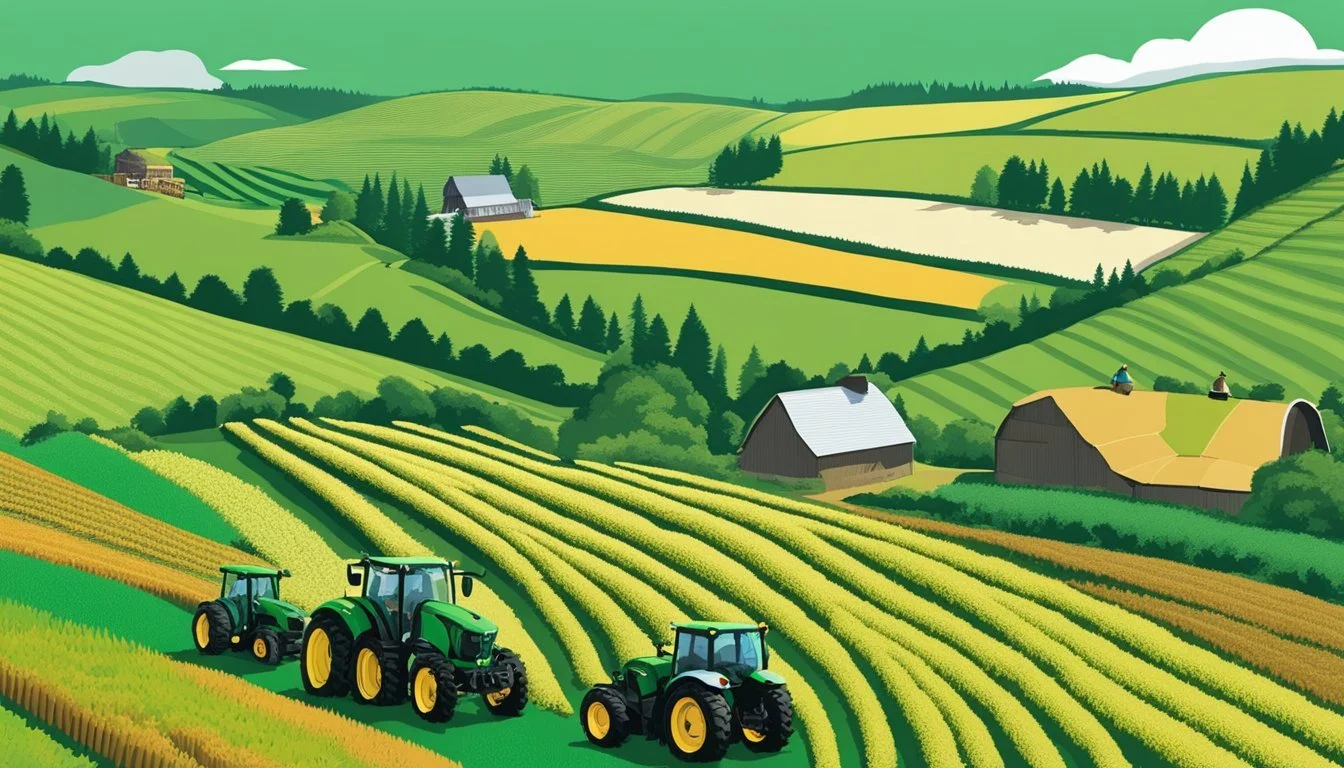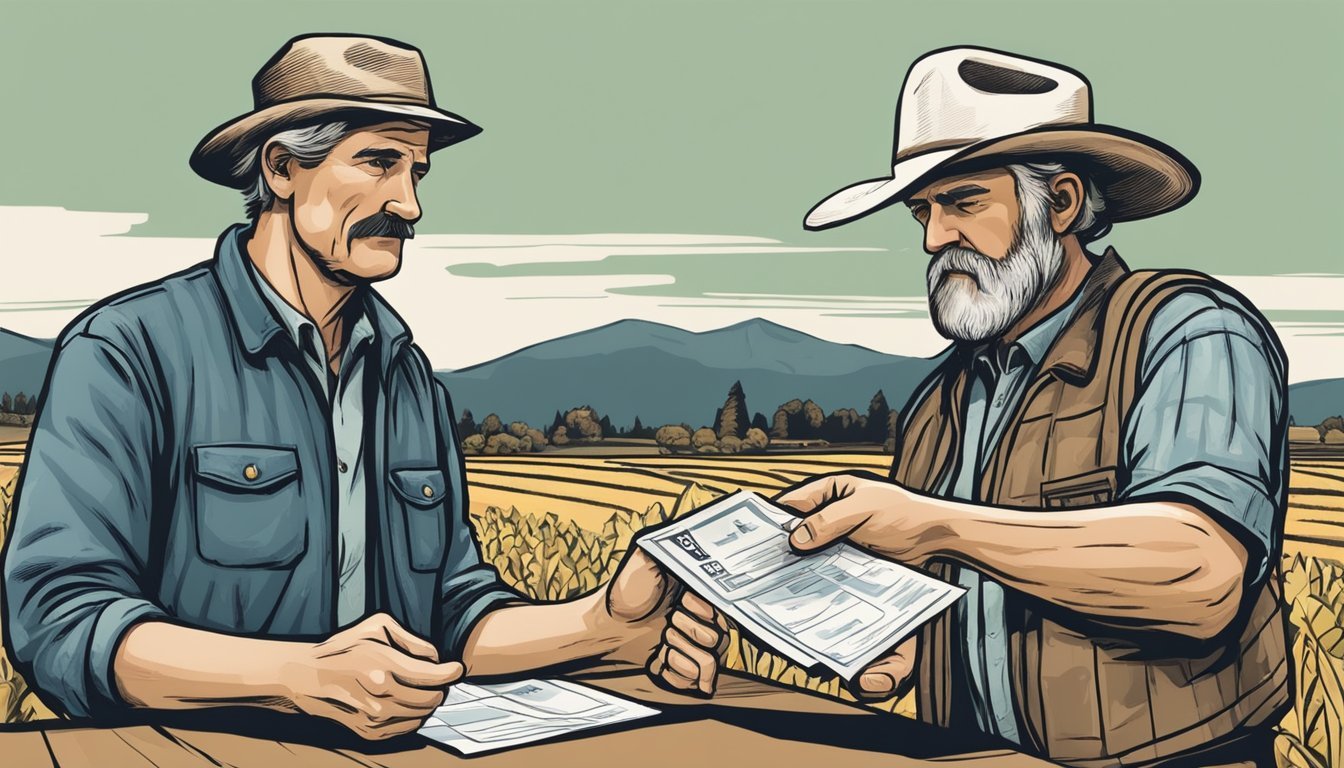Farming Grants Oregon
Navigating Opportunities for Agricultural Funding
Oregon remains a cornerstone of American agriculture, with its diverse range of climates and crops. To support the growth and sustainability of this vital sector, various grants and funding opportunities are made available to farmers across the state. These resources aim to bolster the production capabilities, increase the competitiveness of specialty crops, and provide relief in the wake of natural disasters. The Oregon Department of Agriculture spearheads initiatives offering grants, loans, and technical assistance to ensure the state's agriculture remains vibrant and forward-moving.
Specific programs target different needs within the farming community. For example, the Specialty Crop Block Grant program is designed to support nonprofits, local governments, producer groups, and educational institutions that work to enhance the competitiveness of Oregon's specialty crops. On the other hand, federal assistance through programs like the USDA Farm Service Agency offers Emergency Assistance for Livestock, Honeybees, and Farm-Raised Fish to mitigate the financial impact of natural disasters on producers.
Moreover, the Resilient Food Systems Infrastructure Grant Program focuses on strengthening the agricultural infrastructure by providing financial support for equipment-only purchases. As demand for sustainable and resilient farming methods grows, Oregon's agriculture grants play a crucial role in addressing current challenges and ensuring a robust food system for the future.
Understanding Farming Grants in Oregon
Farming grants in Oregon present opportunities for producers to secure funding that enhances agricultural practices and market competitiveness. These grants are a vital resource for sustaining and scaling farm operations within the state.
Eligibility Criteria for Oregon Farming Grants
To qualify for farming grants in Oregon, applicants usually need to fulfill certain requirements. First and foremost, they must be involved in agricultural production. This can encompass a wide range of activities, from crop cultivation to livestock rearing. Second, a solid business plan is often mandatory to demonstrate the feasibility and potential for success of the proposed project. Moreover, specific grant programs may prioritize certain groups such as beginning farmers, small and mid-sized producers, or those implementing sustainable practices.
Overview of State and Federal Grant Programs
Various grant programs are available through both state and federal channels. Federal programs, commonly provided by the U.S. Department of Agriculture (USDA), offer financial assistance through initiatives such as the:
Value-Added Producer Grant (VAPG) Program: Assists producers in creating value-added products and expanding their marketing potential.
Emergency Assistance for Livestock, Honeybees, and Farm-Raised Fish Program (ELAP): Provides aid in the event of natural disasters.
On the state level, the Oregon Department of Agriculture (ODA) distributes funding through programs like the Specialty Crop Block Grant to bolster the market presence of Oregon's specialty crops.
Role of the Oregon Department of Agriculture
The ODA plays a significant role in administering grant programs and providing technical support to Oregon's farming community. The department not only administers Specialty Crop Block Grants, but also serves as a liaison to federal agencies, ensuring that local farmers have access to the latest information and resources. In addition to grant management, ODA offers guidance on compliance with agricultural regulations and best practices in farming.
By having access to federal and state resources, farmers in Oregon can seek funding solutions tailored to their specific needs and continue contributing to the state's diverse agricultural landscape.
Funding Opportunities for Oregon Farmers
Oregon farmers have a variety of funding opportunities available to support their agricultural projects. These encompass grants specifically for new and beginning farmers, programs focused on specialty crops, conservation initiatives, and assistance for developing value-added products and exploring new markets.
Grants for New and Beginning Farmers
New and beginning farmers in Oregon may find financial support through various grant programs. Although direct grants for starting a farm are rare, they can find assistance for business planning, equipment purchase, and educational resources.
Specialty Crop Block Grant Program
The Specialty Crop Block Grant Program is designed to support the specialty crop sector. Funding is targeted to help develop new market opportunities for crops such as fruits, vegetables, tree nuts (how long do nuts last?), and nursery crops.
Conservation and Environmental Grants
Farmers focused on conservation have access to programs like the Environmental Quality Incentives Program (EQIP). These grants encourage practices that improve soil health, conserve water, and enhance wildlife habitat.
Value-Added Products and Market Expansion Grants
To encourage innovation and expansion in the agricultural market, Oregon offers grants for value-added products. The Value Added Producer Grants support farmers in developing new products, marketing, and increasing their competitiveness in the marketplace.
Resource and Capital Acquisition
Acquiring capital and resources is critical for the development and sustainability of farms in Oregon. Producers must navigate through various grants, loans, and technical assistance opportunities to secure the necessary support.
Finding Capital for Farm Development
In Oregon, securing capital for farm development often begins with loans, as grants are not commonly available for initial start-ups. Producers should consider federal and state loan options. The USDA Farm Service Agency offers programs like the Farm Operating Loans, which provide capital to start, maintain, and strengthen a family farm.
Technical Assistance Resources
Technical assistance in Oregon is available to help producers develop sound business plans essential for loan and grant applications. For example, the Energy Trust of Oregon provides assistance and funding for energy-efficiency projects on farms. Resources are designed to guide farm owners through the complexities of energy upgrades, irrigation investments, and more.
Leveraging Loans and Grant Funding
Oregon farmers can leverage a mix of loans and grant funding for various projects. For instance:
Conservation Reserve Program (CRP): Encourages producers to improve water quality and control soil erosion.
Value Added Producer Grants: Supporting planning and working capital expenses with certain matching fund requirements.
By strategically combining loans and grants, Oregon farmers can optimize their funding and potentially lessen the financial burden of their agricultural pursuits.
Navigating the Application Process
Particular attention to detail is essential when navigating the application process for farming grants in Oregon. Producers must be acutely aware of application guidelines, deadlines, and financial nuances such as reimbursement rates and cost-share programs. The following subsections provide specific insights into these aspects to support applicants through the process.
Application Guidelines and Deadlines
Application Requirements: Every grant has specific requirements which may include the size of the operation, the type of crops grown, or the demographic of the producer. It is essential to read the funding opportunity announcement thoroughly to ensure eligibility.
Deadlines: Grants often have a strict application window. For example, applications for Value Added Producer Grants are announced in the Federal Register and on Grants.gov annually. Applicants should mark these dates prominently and prepare in advance to meet these time-sensitive milestones.
Assembling a Strong Business Plan
A robust business plan should articulate the farm's vision, mission, strategies, and the impact of the grant. Key elements include:
Executive Summary: A concise overview of the business and funding needs.
Market Analysis: Understanding of the market demand and how the business intends to meet it.
Financial Projections: Detailed budgeting, expected revenue, and the sustainability of the project.
This blueprint should not only guide farm operations but also convince funders of the project's viability and the producer's capability to manage grant funds effectively.
Understanding Reimbursement and Cost-Share Programs
Reimbursement: Most grants operate on a reimbursement basis, meaning expenses are paid out-of-pocket upfront and reimbursed after proof of expenditures.
Cost-Share Programs: Programs like the "Conservation Innovation Grants" in Oregon may require the producer to cover a certain percentage of project costs. Applicants should plan accordingly for their share of the investment.
It is critical for applicants to fully grasp the financial obligations they are committing to and ensure they have the means to cover costs until reimbursement is secured.
Managing and Sustaining Farm Operations
Ongoing farm operations in Oregon demand robust strategies for conservation, adapting to environmental shifts, and planning for future generations. Farm owners and managers are encouraged to integrate proactive measures to ensure the vitality of their land and the continuity of their business.
Soil and Water Conservation Techniques
Farmers in Oregon can apply conservation practices to maintain soil health and manage water use efficiently. Soil and Water Conservation Districts (SWCDs) offer resources and guidance on techniques such as cover cropping, crop rotation, and reduced tillage, which help retain soil fertility and prevent erosion. Water conservation measures may include drip irrigation and scheduling irrigation to align with plant growth cycles to reduce water waste.
Long-Term Planning and Succession
Succession planning is crucial for farm longevity. Developing a detailed business plan can prepare for the eventual transition of farm ownership and management. Resources such as the Conservation Stewardship Program (CSP) aid in implementing conservation activities that benefit long-term operational sustainability. Including succession strategies in business plans ensures that farms can continue to thrive across generations.
Adjusting to Environmental Changes and Challenges
Farmers must stay informed about the risks posed by climate change, including an increased frequency of natural disasters and wildfires. They should employ adaptive practices to withstand such challenges. Participating in programs like the Conservation Reserve Program (CRP) and the Conservation Reserve Enhancement Program (CREP) allows farmers to convert environmentally sensitive land into conservation reserves, which can serve as buffers against adverse environmental events. Adapting to and mitigating the impacts of climate change ensures the farm's resilience in the face of unpredictable conditions.
Community and Economic Development
In Oregon, the intersection of agriculture, community, and economic development centers on strengthening local food systems, engaging with producer groups, and ensuring support for underserved and minority farmers. These initiatives are vital for building resilient food economies that benefit both growers and communities.
Strengthening Local Food Systems
Local food systems in Oregon are key to enhancing regional sustainability and economic growth. Initiatives such as the 2024 Community Grants Program by the Oregon Community Foundation underscore the commitment to these local systems. This focus is aimed at boosting small-scale farms and integrating them into larger, regional food system frameworks. Such efforts offer platforms for local products to gain access to new markets, thus supporting economic vitality.
Engaging with Producer Groups and Cooperatives
Producer groups and cooperatives have a crucial role in community and economic development through collective action. They serve as a means for producers to leverage shared resources and knowledge, resulting in better marketing, distribution, and negotiating power. By engaging with these groups, Oregon's farmers can create more cohesive and powerful entities that enable equity among stakeholders, including farm workers and local businesses.
Support for Underserved and Minority Farmers
Equitable support for underserved and minority farmers, including tribes and veterans, is a key focus in Oregon's agricultural policy. Grants and technical assistance programs are designed to aid beginning farmers and for-profit organizations in overcoming the obstacles they face. This includes access to capital, land, and markets, ensuring that the economic development derived from agriculture is inclusive and beneficial to all communities involved.
Statewide and Regional Programs
Oregon boasts a diverse array of programs aimed at bolstering the agriculture industry. These initiatives encompass statewide efforts from the Oregon Department of Agriculture (ODA), targeted assistance in specific regions like the Willamette Valley, and federal support through the United States Department of Agriculture (USDA).
Programs Specific to the Willamette Valley
The Willamette Valley, a key agricultural area in Oregon, benefits from specialized programs addressing its unique farming needs. One notable initiative is the Technical Assistance for Specialty Crops (TASC) program, which provides support for crops that are the backbone of the valley's agricultural output. Farmers in this region can also apply for grants from the Oregon State Weed Board, focusing on the management of invasive plant species which pose a threat to local biodiversity and crop yields.
Resources for Rural and Coastal Communities
Outside of the Willamette Valley, rural and coastal communities in Oregon are not left behind. Through the Resilient Food Systems Infrastructure Grant Program, agriculturalists can receive assistance to strengthen local and regional food systems, including new revenue streams specifically designed for these areas. Additionally, the Energy Trust of Oregon extends funding and technical assistance to help farming operations become more energy-efficient, a program that also encompasses irrigation and greenhouse upgrades.
Federal Programs Affecting Oregon Agriculture
Farmers in Oregon can take advantage of federal programs as well, with the USDA making its presence felt through the Conservation Innovation Grants (CIG). These grants spearhead the development of new tools and practices aimed at conservation on private lands. The federal government also plays a role in state-specific programs such as the Simplified Equipment Only Grant, which allows up to $100,000 for equipment purchases under the fixed-price grant scheme, provided by Oregon’s collaboration with federal funding options.
Crisis and Emergency Support
In the face of adversity, such as natural disasters and pandemics, Oregon farmers have access to critical resources for emergency assistance. These programs aim to provide immediate relief and support to ensure the stability of agricultural operations.
Assistance for Farmers Facing Natural Disasters
Oregon farmers affected by natural disasters such as wildfires or severe drought conditions can seek help through various federal and state programs. The U.S. Department of Agriculture (USDA) offers technical and financial assistance to farmers and livestock producers under the Emergency Assistance for Livestock, Honeybees, and Farm-Raised Fish Program (ELAP). This support is crucial for producers to recover from losses due to adverse weather events.
Key Programs and Services:
Disaster Assistance: ELAP coverage for livestock and crop losses.
Recovery Assessments: Guidance on damage assessment and steps for recovery.
Oregon Agricultural Boards and Commissions: Local resources tailored to Oregon’s specific needs.
Emergency Support Programs During Pandemic
During the COVID-19 pandemic, emergency support programs have been crucial for Oregon agricultural communities. The state has mobilized resources to provide immediate assistance to dairy producers and other agricultural sectors impacted by the disruption in food supply chains.
Available Services:
Crisis Hotlines: AgriStress Helpline for the Oregon agricultural community, offering free and confidential support.
Technical Aid: USDA’s recommendations for safe operation during health emergencies.
Farmers and producers are encouraged to reach out to their local USDA service centers to learn more about eligibility for these emergency support programs. Specialized guidance is available to help navigate the complexities of each situation and secure the necessary aid.
Staying Informed
For producers in Oregon seeking grants, it is crucial to remain abreast of the latest funding opportunities and resources. Vigilance in tracking updates can give them an edge in securing necessary financial assistance.
Keeping Up with Farming Grant Announcements
Producers should frequently check the Oregon Department of Agriculture website for grant announcements. This agency provides timely information about new and ongoing funding sources. Additionally, Grants.gov is an indispensable resource that lists available federal grants, including those related to agriculture. By regularly visiting these websites, producers can stay current with grant offerings.
Key Resources for Announcements:
Attending Workshops and Networking Events
Workshops and events offer a dual benefit: they serve as a platform for learning, and for networking with peers and experts. The Oregon Department of Agriculture often sponsors events that can provide producers with valuable insights into available grants and technical assistance. Producers can leverage these opportunities to not only gain knowledge but also build relationships that could be beneficial in navigating the funding landscape.
Opportunities to Engage:
Workshops on grant writing and management
Agricultural industry meetings
Networking events with fellow producers and industry experts







